
Inveraray Castle is a country house near Inveraray in the county of Argyll, in western Scotland, on the shore of Loch Fyne, Scotland's longest sea loch. It is one of the earliest examples of Gothic Revival architecture.

Archibald Campbell, 3rd Duke of Argyll, 1st Earl of Ilay, was a Scottish nobleman, politician, lawyer, businessman, and soldier. He was known as Lord Archibald Campbell from 1703 to 1706, and as the Earl of Ilay from 1706 until 1743, when he succeeded to the dukedom. He was the dominant political leader in Scotland in his day, and was involved in many civic projects.

Dalmeny House is a Gothic revival mansion located in an estate close to Dalmeny on the Firth of Forth, to the north-west of Edinburgh, Scotland. It was designed by William Wilkins, and completed in 1817. Dalmeny House is the home of the Earl and Countess of Rosebery. The house was the first in Scotland to be built in the Tudor Revival style. It provided more comfortable accommodation than the former ancestral residence, Barnbougle Castle, which still stands close by. Dalmeny today remains a private house, although it is open to the public during the summer months. The house is protected as a category A listed building, while the grounds are included in the Inventory of Gardens and Designed Landscapes in Scotland.

Brodick Castle is a castle situated outside the port of Brodick on the Isle of Arran, an island in the Firth of Clyde, Scotland. It was previously a seat of the Dukes of Hamilton, but is now owned by the National Trust for Scotland. The castle is a Category A listed building and the grounds are included in the Inventory of Gardens and Designed Landscapes in Scotland.

Duart Castle, or Caisteal Dhubhairt in Scottish Gaelic, is a castle on the Isle of Mull, beside the Sound of Mull off the west coast of Scotland, within the council area of Argyll and Bute. The castle dates back to the 13th century and is the seat of Clan MacLean. One source states that the castle was "brought back from ruin in 1911".
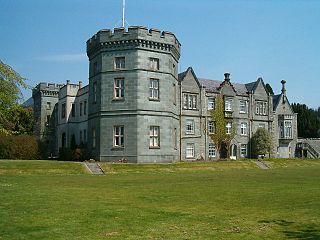
Kilmory Castle, also known as Kilmory House, is a large 19th century house located just to the south of Lochgilphead, in old county Argyll, on the west coast of Scotland. It is currently occupied by the headquarters of the Argyll and Bute Council. The gardens are open to the public and form part of a country park on the former estate. The house is protected as a category B listed building.

Harviestoun is an estate in Tillicoultry parish, Clackmannanshire, central Scotland. It lies at the base of the Ochil Hills, around 1.5 kilometres (0.93 mi) east of Tillicoultry and 2 kilometres (1.2 mi) west of Dollar.
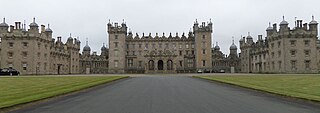
Floors Castle, in Roxburghshire, south-east Scotland, is the seat of the Duke of Roxburghe. Despite its name it is an estate house rather than a fortress. It was built in the 1720s by the architect William Adam for Duke John, possibly incorporating an earlier tower house. In the 19th century it was embellished with turrets and battlements, designed by William Playfair, for The 6th Duke of Roxburghe. Floors has the common 18th-century layout of a main block with two symmetrical service wings. Floors Castle stands by the bank of the River Tweed and overlooks the Cheviot Hills to the south.

Taymouth Castle is situated to the north-east of the village of Kenmore, Perth and Kinross, in the Highlands of Scotland, in an estate which encompasses 450 acres. It lies on the south bank of the River Tay, about a mile from Loch Tay, in the heartland of the Grampian Mountains. Taymouth is bordered on two sides by mountain ranges, by Loch Tay on the third and by the confluence of the rivers Lyon and Tay on the fourth.

Clan MacAlister is a Scottish Clan. The clan is the earliest branch to have split off from Clan Donald, claiming descent from Alasdair Mòr, son of Domhnall founder of Clan Donald. From Alasdair Mòr the clans takes its surname MacAlister; this surname is an Anglicisation of the Gaelic MacAlasdair meaning "son of Alasdair". In the 15th century the chief of the clan was seated in Kintyre, and the clan was centred there until the 18th century, when a chief sold the family estate in preference to an estate in the Scottish Lowlands.
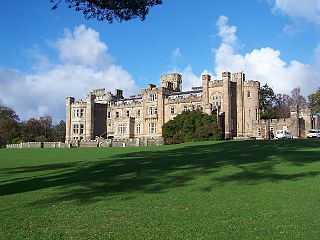
Castle Toward is a nineteenth-century country house in Argyll and Bute, Scotland.

Buchanan Castle is a ruined castle in Stirlingshire, Scotland, located 1 mile (1.6 km) west of the village of Drymen. The house was commissioned by The 4th Duke of Montrose and built in 1852-1858 as a home for the Montrose family, serving as such until 1925. It was built as a replacement for Buchanan Auld House, which is located 0.5 miles (0.80 km) to the northwest but was destroyed in a fire in 1852. The old house and surrounding lands had been the property of the Clan Buchanan but passed to the Clan Graham in the late 17th century. The roof of the building was removed in 1954 and the condition of the house has since deteriorated, but it remains the seat of the Clan Graham.

Jura is an island in the Inner Hebrides of Scotland, adjacent to and northeast of Islay. With an area of 36,692 hectares (142 sq mi), and 196 inhabitants recorded in the 2011 census, Jura is more sparsely populated than Islay, and is one of the least densely populated islands of Scotland: in a list of the islands of Scotland ranked by size, Jura comes eighth, whereas by population it comes 31st. The island is mountainous, bare and largely infertile, covered by extensive areas of blanket bog.

Tarbert Castle is located on the southern shore of East Loch Tarbert, at Tarbert, Argyll, Scotland, at the north end of Kintyre. Tarbert Castle was a strategic royal stronghold during the Middle Ages and one of three castles at Tarbert. The castle overlooks the harbour and although pre 14th century in construction, the tower dates back to 1494 and the visit of James IV to the Western Highlands.

Stobo Castle is located at Stobo in the Scottish Borders, in the former county of Peeblesshire. The Manor of Stobo was originally owned by the Balfour family. It became the family seat of the Graham-Montgomery Baronets from 1767. The building of the present castle began in 1805 and was completed in 1811 under the supervision of architects Archibald and James Elliot. It is currently operated as a health spa. The house is protected as a category A listed building, while the grounds are included in the Inventory of Gardens and Designed Landscapes in Scotland, the national listing of significant parks and gardens.
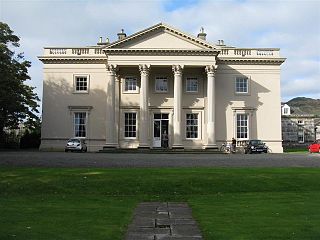
Duddingston House is an 18th-century mansion in Edinburgh, Scotland, located south-east of the village of Duddingston. It was built in the 1760s for James Hamilton, 8th Earl of Abercorn, and was designed by Sir William Chambers. It is now protected as a category A listed building, and the grounds of the house are included in the Inventory of Gardens and Designed Landscapes in Scotland, the national listing of significant gardens.

The Glen, also known as Glen House, is an estate and country house in the parish of Traquair, southern Scotland. It is located in the glen of the Quair Water, around 5 kilometres (3 mi) south-west of Innerleithen, and 9 kilometres (5.6 mi) south-east of Peebles, in the Scottish Borders. The estate is recorded from the 13th century, but the present Glen House was built in the mid 19th century. The house is protected as a category A listed building, and the grounds are included in the Inventory of Gardens and Designed Landscapes in Scotland, the national listing of significant gardens. Besides the house, the Temple, stables, and the "Lion Gate" are also category A listed.
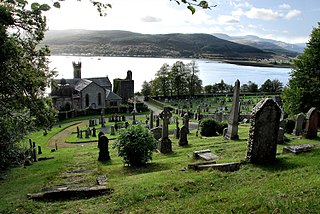
Kilmun Parish Church and Argyll Mausoleum in Kilmun, Argyll and Bute, Scotland, consists of St Munn's Church, as well as the adjacent mausoleum of the Dukes of Argyll and a historically significant churchyard. The complex is located on the summit of a slight knoll about ten metres from the shoreline of the Holy Loch on the Cowal Peninsula in Argyll, Scotland. The existing church dates from 1841 and occupies the site of an older, medieval church. A partly ruined tower from the medieval period still stands to the west of the present building.
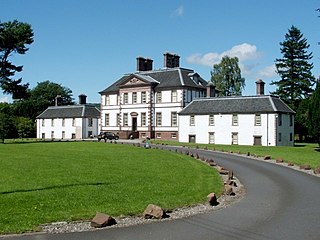
Strathleven House is an early 18th-century country house in West Dunbartonshire, Scotland. It is located in the Vale of Leven, around 3 kilometres (1.9 mi) north of Dumbarton. Built in 1700, it is probably the work of the architect James Smith, and has been described as "the earliest surviving example of the classic Palladian country house in Scotland". Strathleven House, and its 18th-century dovecote, are protected as category A listed buildings,

Ardkinglas House is a Category A listed country house on the Ardkinglas Estate in Argyll, Scotland. The estate lies on the eastern shore of Loch Fyne, and the house is located close to the village of Cairndow. Dating back to the 14th century and originally a Campbell property, the estate now covers more than 12,000 acres (4,900 ha) of rolling hills and landscaped parkland. The centre of the estate was Ardkinglas Castle until this was replaced by a new house in the 18th century. This house was itself replaced by the present Ardkinglas House in the early 20th century, designed by Sir Robert Lorimer for Sir Andrew Noble. It remains the property of the Noble family, and is open to the public on a limited basis. The woodland gardens are open all year round.





















